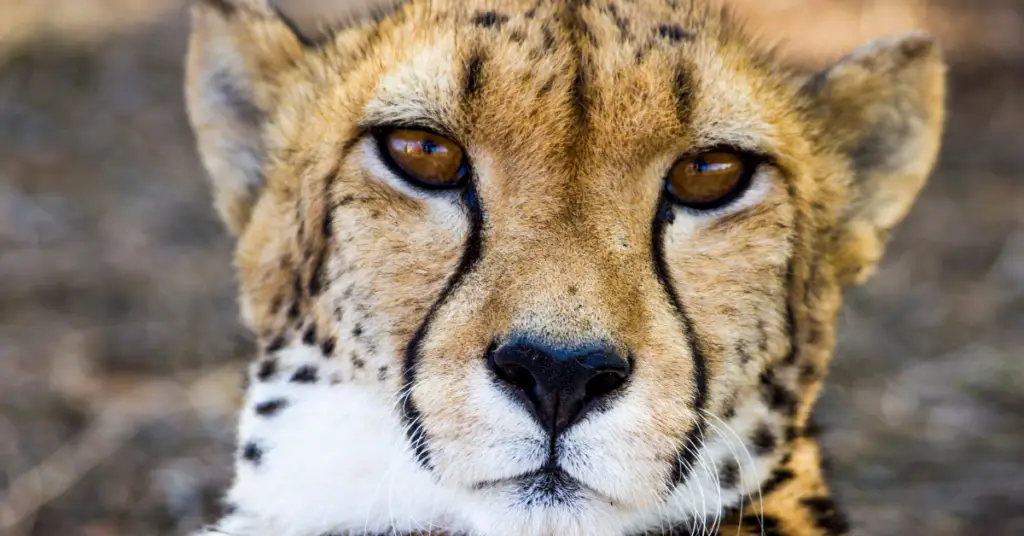Scientific Name of Cheetah: Acinonyx jubatus
Conversational Status: Vulnerable (Critically Endangered: North Africa and Asia)
Body Length: 112 to 135cm
Wild Population: < 7000
Weight: 28 to 60kg
Gestation: 95 days
Number of offspring: 1 to 8
Habitat: Grasslands, savannas, dense vegetation and mountainous terrain. Distribution areas can extend over 1000 square kilometers.
Distribution: Current range in Africa and Asia is reduced to fragmented populations with the highest numbers in Namibia and Botswana. A small population of about 50 in Iran..
Cheetahs are the fastest land animals on earth. A cheetah has slender, long, muscular legs and a slender body. Its head is small and round.A cheetah also has a flexible spine, deep chest, and special pads on the feet for traction. A long-tail helps the cheetah balance itself when making quick turns while hunting. Cheetahs run short distances for 20 to 60 seconds at speeds of up to 70 miles per hour.
Cheetahs are the smallest members of the big cat family, typically weighing between 110 and 140 pounds. A distinctive feature distinguishes them from other cats. A long black line runs from the inside of each eye to the mouth. This “tear mark” it is believed to have a role in protecting cheetahs’ eyes from strong sunlight and helps them see great distances.
Cheetahs don’t roar like other big cats. They emit a very loud purr when preening. They moan, growl, hiss, and make a bird-like sound. Noise is very distinctive and different from noise. other big cats do. Cheetahs cannot climb trees like other big cats because they have blunt claws.
Cheetahs used to live throughout Africa and Asia, but today they are only found in parts of East, Central, and South West Africa and small parts of Iran. They live in the biome known as the savannah, where they rely on tall grasses for camouflage when hunting.
Because they have poor night vision, cheetahs typically hunt in the late morning or early evening, unlike other big cats.
A cheetah gets as close as possible to its prey and then uses a burst of speed to attempt to outrun it. As soon as the cheetah reaches the animal, it knocks it to the ground with its paw and suffocates it with a bite in the neck. A cheetah eats quickly because other predators such as hyenas, vultures, and jackals will aggressively try to steal what they catch.
Cheetahs are solitary animals. Female cheetahs take care of their cubs alone. There are often 2-4 pups in a litter and mothers tend to move their pups to new dens every few days. At five weeks of age, the pups follow their mother and learn to eat their prey. Mothers often bring small animals to their young. to teach them how to hunt and catch prey.
The cheetah population has been declining over the past 100 years. In 1900 there were approximately 100,000 cheetahs in Africa and Asia. Today it is estimated that there are only between 9,000 and 12,000 cheetahs left on earth. The future of the cheetah is uncertain.

Erzsebet Frey (Eli Frey) is an ecologist and online entrepreneur with a Master of Science in Ecology from the University of Belgrade. Originally from Serbia, she has lived in Sri Lanka since 2017. Eli has worked internationally in countries like Oman, Brazil, Germany, and Sri Lanka. In 2018, she expanded into SEO and blogging, completing courses from UC Davis and Edinburgh. Eli has founded multiple websites focused on biology, ecology, environmental science, sustainable and simple living, and outdoor activities. She enjoys creating nature and simple living videos on YouTube and participates in speleology, diving, and hiking.
- WILDLIFE THEMED T-SHIRTS
Cute Hedgehog Embroidered: Love Wildlife, Protect Nature Wildlife conservation tees
$35.00







